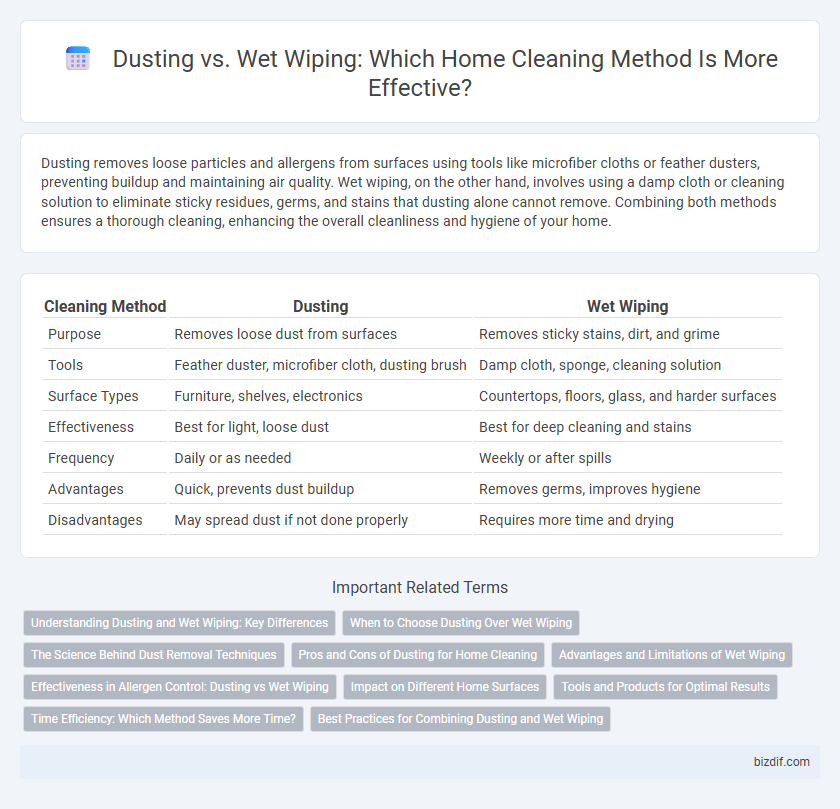Dusting removes loose particles and allergens from surfaces using tools like microfiber cloths or feather dusters, preventing buildup and maintaining air quality. Wet wiping, on the other hand, involves using a damp cloth or cleaning solution to eliminate sticky residues, germs, and stains that dusting alone cannot remove. Combining both methods ensures a thorough cleaning, enhancing the overall cleanliness and hygiene of your home.
Table of Comparison
| Cleaning Method | Dusting | Wet Wiping |
|---|---|---|
| Purpose | Removes loose dust from surfaces | Removes sticky stains, dirt, and grime |
| Tools | Feather duster, microfiber cloth, dusting brush | Damp cloth, sponge, cleaning solution |
| Surface Types | Furniture, shelves, electronics | Countertops, floors, glass, and harder surfaces |
| Effectiveness | Best for light, loose dust | Best for deep cleaning and stains |
| Frequency | Daily or as needed | Weekly or after spills |
| Advantages | Quick, prevents dust buildup | Removes germs, improves hygiene |
| Disadvantages | May spread dust if not done properly | Requires more time and drying |
Understanding Dusting and Wet Wiping: Key Differences
Dusting involves removing loose particles and allergens from surfaces using dry cloths or dusters, which helps maintain air quality and prevents buildup. Wet wiping employs a damp cloth or cleaning solution to eliminate sticky residues, stains, and bacteria, ensuring deeper sanitation. Choosing between dusting and wet wiping depends on surface type and cleaning goals, as dusting is ideal for delicate electronics while wet wiping suits countertops and high-contact areas.
When to Choose Dusting Over Wet Wiping
Dusting is ideal for delicate surfaces and electronics where moisture could cause damage, such as wooden furniture, picture frames, and keyboards. It effectively removes loose dust particles without spreading dirt or causing smudges, preserving the integrity of sensitive materials. Choose dusting over wet wiping when the goal is to maintain dryness and prevent residue buildup on fragile surfaces.
The Science Behind Dust Removal Techniques
Dusting involves using microfiber cloths or electrostatic dusters that attract and trap dust particles through static electricity, effectively removing loose debris without spreading allergens. Wet wiping employs damp cloths or cleaning solutions to dissolve and lift dirt, oils, and fine dust particles, providing a deeper clean by preventing dust from resettling on surfaces. Studies show combining both methods enhances indoor air quality by minimizing airborne dust and allergens more efficiently than using dusting or wet wiping alone.
Pros and Cons of Dusting for Home Cleaning
Dusting efficiently removes loose dirt and allergens from surfaces, making it ideal for regular maintenance and quick cleaning sessions. However, it may also disperse dust particles into the air, potentially triggering allergies and requiring follow-up cleaning to capture settled dust. Unlike wet wiping, dusting does not eliminate sticky residues or deep grime, limiting its effectiveness on heavily soiled areas.
Advantages and Limitations of Wet Wiping
Wet wiping effectively removes stubborn dirt and grime by using moisture to dissolve and lift particles, making it ideal for surfaces like glass, stainless steel, and countertops. Its advantage lies in deeper cleaning and sanitization, reducing allergens and bacteria more efficiently than dry dusting. However, wet wiping can be time-consuming, may damage moisture-sensitive surfaces, and requires careful drying to prevent streaks or water damage.
Effectiveness in Allergen Control: Dusting vs Wet Wiping
Dusting often stirs up dust particles, which can temporarily increase allergens in the air, reducing its effectiveness in allergen control. Wet wiping traps and removes dust, pollen, and pet dander more efficiently, significantly reducing airborne allergens. Consistently using wet wiping techniques provides a cleaner and healthier living environment by minimizing allergen exposure.
Impact on Different Home Surfaces
Dusting effectively removes loose particles from surfaces like wooden furniture, electronics, and delicate decor without causing damage or streaks. Wet wiping provides a deeper clean by eliminating sticky residues and stains on hard surfaces such as countertops, glass, and tiles, but may warp or degrade untreated wood and certain fabrics. Choosing the appropriate method based on surface material preserves longevity and maintains optimal cleanliness.
Tools and Products for Optimal Results
Microfiber cloths and electrostatic dusters excel in dusting by trapping fine particles without spreading allergens, while damp microfiber cloths and mild cleaning solutions are essential for wet wiping to remove sticky residues and disinfect surfaces. Using specific tools like vacuum cleaners with HEPA filters enhances dust removal in hard-to-reach areas, whereas wet wipes infused with antibacterial agents provide effective surface sanitation. Selecting the right combination of dusting tools and wet wiping products ensures thorough cleaning, minimizes airborne dust, and maintains a hygienic home environment.
Time Efficiency: Which Method Saves More Time?
Dusting typically saves more time than wet wiping because it involves quickly removing surface dust with a dry cloth or duster, making it ideal for routine cleaning of large areas. Wet wiping requires more preparation and drying time, especially on stubborn grime or sticky residues, which can slow down the process. For time efficiency, dusting is preferable for regular maintenance, while wet wiping is better suited for deeper cleaning tasks.
Best Practices for Combining Dusting and Wet Wiping
For optimal home cleaning results, combine dusting and wet wiping by first removing loose dust particles with a microfiber cloth or duster to prevent spreading debris during wet wiping. Follow dusting with wet wiping using a damp cloth and an appropriate cleaning solution to eliminate residual grime and allergens on surfaces such as countertops, shelves, and furniture. Regularly maintaining this sequence helps improve indoor air quality and preserves the finish of household items.
Dusting vs Wet wiping Infographic

 bizdif.com
bizdif.com